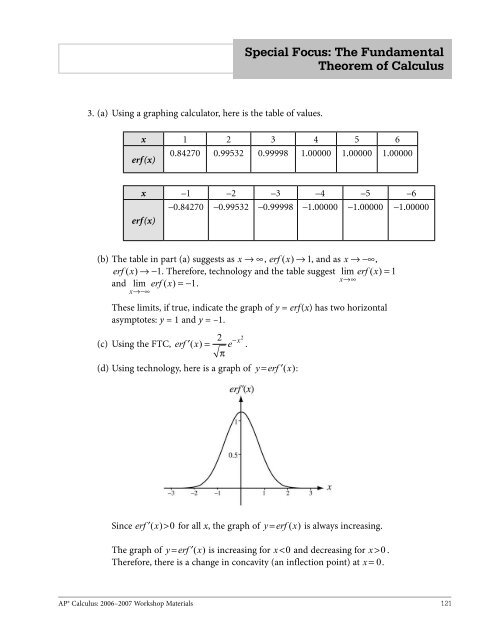AP Calculus
You also want an ePaper? Increase the reach of your titles
YUMPU automatically turns print PDFs into web optimized ePapers that Google loves.
Special Focus: The Fundamental<br />
Theorem of <strong>Calculus</strong><br />
3. (a) Using a graphing calculator, here is the table of values.<br />
x 1 2 3 4 5 6<br />
erf(x)<br />
0.84270 0.99532 0.99998 1.00000 1.00000 1.00000<br />
x –1 –2 –3 –4 –5 –6<br />
–0.84270 –0.99532 –0.99998 –1.00000 –1.00000 –1.00000<br />
erf(x)<br />
(b) The table in part (a) suggests as x → ∞, erf ( x) → 1, and as x → −∞,<br />
erf ( x) → −1. Therefore, technology and the table suggest lim erf ( x) = 1<br />
x→∞<br />
and lim erf ( x) = −1.<br />
x→−∞<br />
These limits, if true, indicate the graph of y = erf(x) has two horizontal<br />
asymptotes: y = 1 and y = –1.<br />
2 −<br />
(c) Using the FTC, erf ′( x)<br />
= e x 2<br />
.<br />
π<br />
(d) Using technology, here is a graph of y = erf ′( x):<br />
Since erf<br />
′( x) > 0 for all x, the graph of y = erf ( x) is always increasing.<br />
The graph of y erf x = ′( ) is increasing for x 0 .<br />
Therefore, there is a change in concavity (an inflection point) at x = 0.<br />
<strong>AP</strong>® <strong>Calculus</strong>: 2006–2007 Workshop Materials 121


